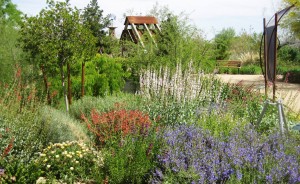by Daniel Murphy
Water is a precious natural resource and an essential element for life on earth. Demand for water increases dramatically as human population grows and fresh water sources become polluted.
Awareness of our reliance on water is especially heightened during times of drought, like the historical droughts now occurring in the western states. Some regions of the planet are inherently dry. The region where I live (Boise, ID) receives on average about 12 inches of precipitation annually. Compare that to a place like Pensacola, Florida which receives around 65 inches annually, or El Paso, Texas which is lucky to get around 8 inches of rain a year.
Whether it is out of necessity — enduring a drought or living in a dry climate — or simply the desire to be a responsible citizen of planet earth, many people are choosing to incorporate more drought tolerant plants in their landscapes, replacing water hungry plants in an effort to conserve water.
In the early 1980s, landscaping with drought-tolerant plants was given the name xeriscaping by the water department in Denver, CO. These days terms like water-wise gardening and water efficient landscaping seem to be more popular.
The initial vision that many people may have of a landscape planted with water-efficient plants is one filled with desert plants like cacti, yuccas, and other succulents, along with gray shrubs like sagebrush and saltbush. While landscapes like these, if done well, can actually be quite attractive, modern water-wise gardens do not have to be so cacti-centric.
As interest in water efficient gardening has grown in recent years, the horticulture industry has been busy introducing a wide variety of plants that are not only drought tolerant but are lush, green, and full of color. Industry groups like Plant Select and retail nurseries like High Country Gardens are proof of this.
STRATEGIES FOR DROUGHT
Plants that are native to regions with frequent or extended droughts are called xerophytes. Over time they have developed a variety of mechanisms that allow them to survive and even thrive in dry environments. Ecologists call these mechanisms “strategies,” or sets of coordinated adaptive traits.
Scores of plants live in regions like this, spanning numerous taxonomic genera and families. Each plant species is worthy of exploration, but for the sake of an introduction, what follows is a brief overview of the strategies that these drought adapted plants use to cope with low-water environments.
Alternate Photosynthetic Pathways: Conventional photosynthesis is inherently inefficient when temperatures are high and water availability is low. Plants that evolved in hot and/or dry environments have developed alternate photosynthetic pathways in order to overcome these inefficiencies.
These alternate pathways involve a few different mechanisms, including utilizing a different protein to fix carbon, splitting the photosynthetic process into two separate cells, and collecting carbon dioxide at night and converting it to sugars during the day. The photosynthetic pathways commonly used by plants adapted to dry environments are known as C4 and CAM.
Drought Avoidance: Many desert plants live most of their lives as seeds hanging out on the desert floor waiting for rain. These are seeds of short-lived annual plants that sprout and grow when the rainy season comes around. They flower, set seed, and are gone by the time the hot, dry season returns. Birdcage evening primrose (Oenothera deltoides) and desert sand verbena (Abronia villosa) are examples of these desert ephemerals.
Drought Dormancy: Some desert trees and shrubs shed their leaves during dry periods and then put out new leaves when rains return. This is called drought deciduous. Other desert plants live out the dry season as fleshy roots or underground stems. These plants typically put out foliage in the spring, when conditions are favorable. They flower, set seed, and then die back as the heat of summer arrives. Arrowleaf balsamroot (Balsamorhiza sagitatta) is a good example of this strategy; it spends much of the year as a taproot with little or no sign of its existence above ground. These spring flowering plants are a great source of early food for emerging pollinators, and are also browsed by deer, elk, antelope, and other wildlife.
Physical Adaptations: Desert plants have many physical adaptations that allow them to survive in hot, dry climates. The thick, fleshy leaves of cacti and other succulents store water for future use.
The roots of some desert plants are shallow but horizontally extensive in order to capture water more effectively when rains come. The roots of other desert plants extend deep into the ground, some – like the roots of mesquite (Prosopis spp.) – even reach as deep as the water table.
Palo verdes (Parkinsonia spp.) are drought deciduous trees and shrubs with photosynthetic bark that can keep photosynthesizing even when leaves are not present. Other adaptations include small leaves, hairy leaves, dull-colored leaves, and waxy leaves – all of which help reduce water loss and improve the efficiency of photosynthesis.
Many low water use plants may already be present in your landscape without you even knowing it. From my experience, we tend to overwater (or inefficiently water) our landscapes – even water thirsty plants are often given more water than necessary.
Dialing back our water use will reveal the true drought contenders. Observing the features of these survivors will reveal the strategies they use to cope with little water. Awareness of these strategies can help us select plants suitable for our landscapes. With the proper plants in place, we can adjust our irrigation schedules to reflect the conditions we live in and the respect we have for this precious and life-giving resource.
Daniel Murphy is a horticulturist in Boise, ID. Visit his blog at http://awkwardbotany.com/.
